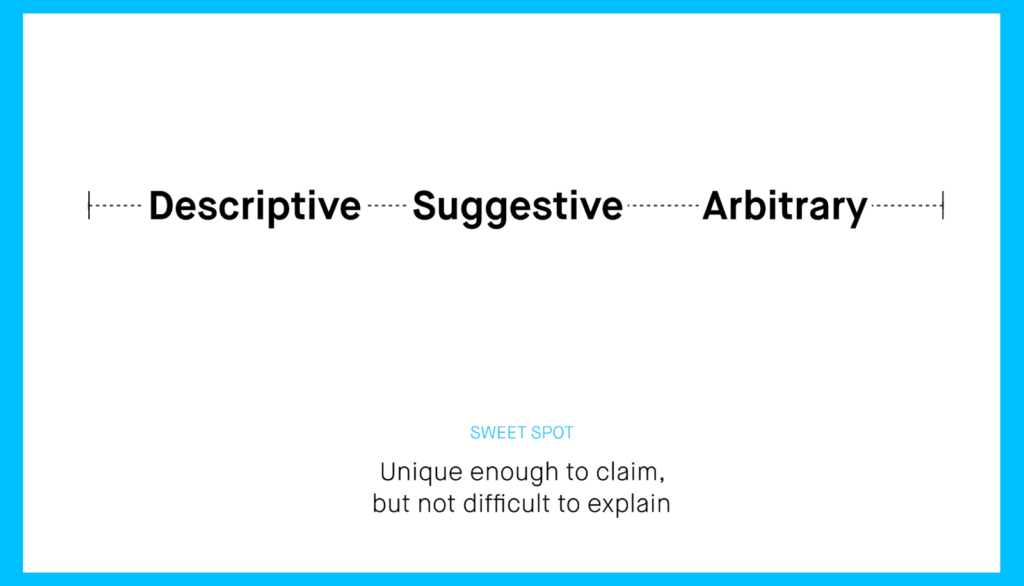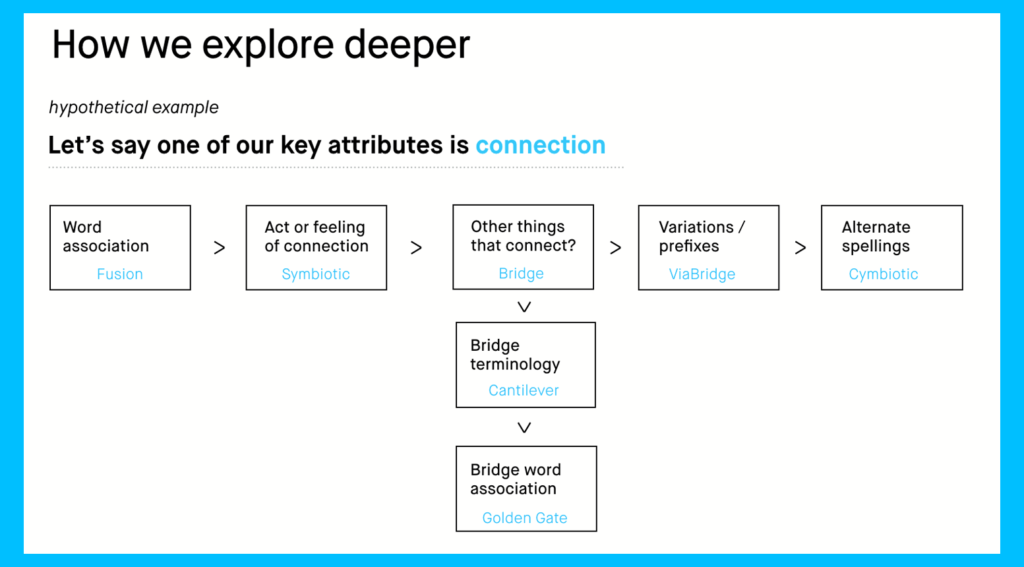Naming a startup that scales, Part 1: Strategic brainstorming
Let’s be honest. Entrepreneurs have a lot on their plates. Taking your startup from the whiteboard to the boardroom is no small feat. Done right, it’s a business model of unmatched opportunity. There’s no reason your big idea can’t become the next Snapchat, the next Airbnb, the next Slack.
But before your startup can take over the world—it’s gonna need a name.
For some, the naming process is a cinch. Divine inspiration. Happenstance. Serendipity. Dumb luck. Whatever you call it…sometimes it just works out.
Case in point: Spotify. Before the streaming startup transformed the way we listen to music, it was just an idea without a name. On a day like any other, its two founders were shouting potential names back and forth between rooms. One of them misheard the word “Spotify,” which wasn’t registered. So they went with it. Easy peasy.
If that hasn’t worked for you so far, don’t sweat it. That’s why we’re here. We are going to outline for you, from a high-level standpoint, the five-step approach New Kind takes when companies hire us to help with their naming needs.
Step 1: Define your attributes
Go to your kitchen. Grab an apple. Hold it up. Look it over. Consider all the ways you might describe the fruit in your hands.
Note: If you don’t have an apple handy, the preceding exercise can be done with basically anything you have lying around. But just between us, you should probably be eating more fruit.
How it looks. Color, shape, what else do you notice about it?
How it feels. Slick, rough? Firm, squishy? Is it heavy?
How it smells and tastes? Chomp into it. Sweet, bitter, juicy, dry?
The answers to the above questions are what we call the apple’s attributes.
Features, facets, qualities, observable truths, quirks, traits, characteristics. These and a dozen other terms could be substituted for “attributes” if they work for you. No matter what you call them, these attributes, taken together, are the building blocks for your identity—and therefore, your name.
Or, put another way: What are the qualities about your startup or the product you sell that stand out the most? That are core to who you want to be as an organization? When customers or contributors hear the new name, what attributes do you want to communicate most? What are the most important things that would resonate with them?
As an example, say your as yet unnamed startup is an app that helps hikers find nearby trails. Based on what you know about the app itself and its purpose, potential attributes might include:
- exploration
- curiosity
- action/movement
- adventure
- boldness
- technology
- trust
- one with nature
- discovery
- connection
In Step 2, when we get to brainstorming, we’ll ask ourselves “What’s the spirit of [attribute]?” Of boldness? Of trust? Of exploration? These attributes are the source material for your new name.
Come up with as many attributes as you possibly can, then force-rank them. Which attributes feel most true to you? See if you can get it down to between three and five total.
For the purposes of this example (which we’ll come back to later on), let’s say your chosen attributes are “curiosity,” “adventure,” and “one with nature.”
Later, when judging name candidates, you can return to the attributes and ask yourself “Does this convey [attribute]?” That will help you decide whether your name is telling customers everything you want it to about your company, your product, your mission.
Step 2: Brainstorm!
Okay. Now that you’ve got your attributes, the fun really begins.
Time to blow it wide open.
A good brainstorming session calls for equal parts inspiration and perspiration. It’s all well and good to wait for lightning to strike, but there are steps we can take to structure your approach to help the clouds gather more quickly.
Grab a fresh pack of sticky notes, a Sharpie, and find the biggest wall you’ve got. Write down one name idea per sticky note and slap it up on the wall. Come up with as many names as you possibly can. Resist the urge to self-edit. At this stage we’re looking for quantity, not quality. Even your lamest, most destined-for-the-waste-bin ideas deserve a spot on the wall, at least for now. Sometimes there really are diamonds in the rough.
Every brand name falls somewhere on the spectrum from the arbitrary to the descriptive (learn more about the spectrum of distinctiveness). Arbitrary names are easier to claim as your own, because odds are you just made it up out of thin air. Like say, if you named your shoe company Blarkz.
Good news! Blarkz.com is available, and you likely won’t run into any trademark issues. The bad news, however, is you’ll need to invest a lot of time, energy, and money in building meaning into a brand name that is currently meaningless to every human on the planet.
On the other end of the spectrum, employing a entirely descriptive naming strategy isn’t recommended either. Deciding to call your shoe company something obvious like, say, Shoes, Inc. comes with its own set of issues. Finding an available (and affordable) domain will be a chore. Same goes for gaining ground on the SEO front. Protecting your own trademarks and making sure you aren’t infringing on others will be an ongoing challenge. You’ll invest a lot of time, energy, and money to try and stand out among the crowd.
At New Kind we say the sweet spot for a good brand name is “suggestive.” That is, a name that’s unique enough to claim as your own, but one you won’t have to explain. That’s your goal.
A few additional tools and tips to guide your brainstorm
Types of names
- Appropriated – Taking the brand name from a familiar term or association. Ex. Caterpillar, a company that makes large yellow machinery for digging in the dirt.
- Portmanteau – Creating your brand name by smushing two words together. Ex. Nyquil, a sleep aid/medication named by combining “night” and “tranquil.”
- Benefit-Driven – A brand name that conveys the benefits its product or service provides. Ex. Visa, a credit card that—like a real travel visa—takes you anywhere you want to be.
- Function-Driven – These more explicit, more literal brand names clearly convey what the company does or sells. Ex. Groupon, which sells coupons for groups.
- Alliteration – Weaving words with the same sounds is always advantageous. Ex. Krispy Kreme, Skillshare.
- Story-Driven – Having a core narrative at the heart of your name instills a strong connection. Ex. Seventh Generation, a sustainable home goods company with a name based on the great law of the Iroquois, which says every action impacts seven generations.
Paths for exploration
Take one of your chosen attributes and follow the brainstorming exercise below. Spend a good 5-10 minutes on each attribute, following each thread as far as it’ll go.
It always amazes us how many potential names emerge from a single attribute, like Connection in our trail-finding app example. They range from the obvious to the obscure, but are all worthy of a sticky on the wall.
Online resources
Here are a handful of handy websites that can help you have a more productive brainstorm.
- Wordoid – As close to a name generator as we’re comfortable suggesting, Wordoid smartly creates nice-sounding portmanteaus based on your root terms. It will also check against .com and .net URL availability.
- Thesaurus.com – The tried-and-true go-to for synonyms, antonyms, and related words.
- Rhymezone – Designed to find fine rhymes of all kinds.
- Onelook – Multi-function dictionary search for words and phrases, with more robust search options to uncover letter patterns, abbreviations, and other useful word constructions.
- Wordhippo – Another online thesaurus, with additional features for “words beginning with,” “ending with,” pronunciations, and more.
More than anything… you gotta believe. Be prepared to explore deeper and in more directions. Keep your mind open. Expect lots of dead ends—but know they often spawn multiple new paths.
Onward to Part Two!
In Part Two of How to Choose a Startup Name That Scales, we make the switch from name generation to name evaluation—taking all those sticky notes that now cover your walls and figuring out which ones might be viable as a startup name.
If undertaking a strategic naming exercise feels like something you want to do, but just don’t have the capacity or resources to go it alone—that’s what we’re here for.
New Kind can design a naming process that fits your needs, budget, and timeline. We have experience naming companies, events, and products. We could probably help you name your new puppy, too, if you need it.
Get in touch today and let’s name something great together!

